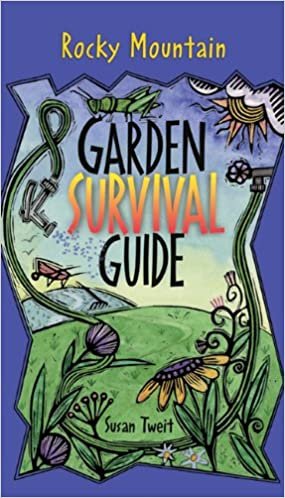Gardening in the severe climates of the Rocky Mountains is a notoriously difficult and frustrating proposition. This "survival guide" proposes to make such extreme gardening less dangerous by explaining how to work with the mountainous environments rather than struggling against nature.
The Rocky Mountains stretch from Canada to Mexico and include a range of elevations from 3,000 to more than 14,000 feet, Plant Hardiness Zones from 3 to 6, and thousands of individual microclimates and frost pockets and steep, barren slopes. For all its diversity, the region is almost uniformly arid or semi-arid, with thin soils, high winds, considerable sunshine and huge temperature changes.
"Gardening in this scenic but difficult region is all about weather," Susan Tweit explains. "Like a good cutting horse or a high-tech mountain bike, Rocky Mountain weather can turn on a dime, from drought to deluge, seering heat to subfreezing cold, dead calm to roaring Chinooks.
"The region's arid climate means that watered and fertilized gardens are a magnet for pests of every size from microbes to moose. Add an increasing number of invasive weeks, the reality of water shortages, and the threat of global climate change, and painting the yard green begins to seem very attractive."
For those determined souls aware of the region's limitations but still determined to cultivate, this is a useful reference. Compiled as a series of one-page tips on everything from rocks and ants to noxious weeds, fungi and pesticides. Interspersed with these are brief essays on garden design, plant selection, and xeriscaping.
Resource lists of Rocky Mountain plants, pests, nurseries, gardens, Internet sites, books and newsletters are includes as sidebars and supplements.
Plants That Won't Get Out of Control
Flowers
Antirrhinum majus (snapdragon) -- This familiar annual garden plant with its spikes of two-lipped flowers in many colors is not native. Unlike its tougher cousin, toadlfax, or butter-and-eggs, it stays in the garden. Insect pollinated and low allergy. Blooms all summer with deadheading. Annual.
Coreopsis verticillara 'Zagreb' (narrow-leaved coreopsis) -- A compact cultivar of 'Moonbeam' coreopsis with star-shaped yellow slowers and narrow leaves. Long blooming, deer resistant, and hardy to Zone 3. Insect pollinated and low allergy. Blooms July through frost.
Geranium 'Johnson's Blue (blue cranesbill). A long-blooming cultivar of Himalayan cranesbill with two-inch-wide blue flowers. Not drought tolerant, but thrives with little additional water. Hardy to Zone 2. Caution: it could spread if watered too frequently. Insect pollinated and low allergy. Blooms June through frost.
Paeonia lactiflora (garden peony) -- Long-lived plants that produce fragrant, beautiful single or double flowers above dark green foilage in early summer. Requires enriched soil, regular watering, and fertilizing after blooming and again in fall. Hardy to Zone 2, low allergy.



